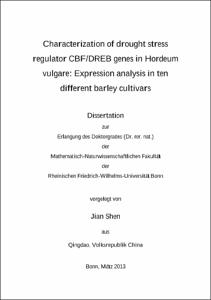Shen, Jian: Characterization of drought stress regulator CBF/DREB genes in Hordeum vulgare : Expression analysis in ten different barley cultivars. - Bonn, 2013. - Dissertation, Rheinische Friedrich-Wilhelms-Universität Bonn.
Online-Ausgabe in bonndoc: https://nbn-resolving.org/urn:nbn:de:hbz:5n-32746
Online-Ausgabe in bonndoc: https://nbn-resolving.org/urn:nbn:de:hbz:5n-32746
@phdthesis{handle:20.500.11811/5715,
urn: https://nbn-resolving.org/urn:nbn:de:hbz:5n-32746,
author = {{Jian Shen}},
title = {Characterization of drought stress regulator CBF/DREB genes in Hordeum vulgare : Expression analysis in ten different barley cultivars},
school = {Rheinische Friedrich-Wilhelms-Universität Bonn},
year = 2013,
month = jul,
note = {Improving crop yield under water deficit environments is an urgent task for crop breeding worldwide. Many efforts have been made to identify key regulators of plant drought stress responses. Most of these studies have been performed with the model plant Arabidopsis thaliana under controlled laboratory conditions. Little work has been done to investigate the functions of these key regulators in the improvement of drought tolerance in crops, especially under field conditions. In the present study, ten barley CBF/DREB gene transcripts (CBF1, CBF2, CBF3, CBF4, CBF6, CBF11, DREB1, DRF1.1, DRF1.3 and DRF2) were isolated from different barley cultivars by using gene-specific primers. Phylogenetic analysis showed that all candidate CBF/DREB genes can be grouped into three phylogenetic subgroups, designated HvCBF1, HvCBF4 and HvDREB1. The phylogenetic distribution of barley CBF/DREB genes in the reconciled tree coincides with their responses to drought. A strongly constitutive expression of the HvDREB1, HvDRF1.1 and HvDRF1.3 genes upon drought has been identified in this study, which is contrary to the published data in the literature. This may be due to the age and physiological state of the plants. By analyzing the CBF expression patterns upon drought in leaf tissues of plants grown in the field, we found that barley cultivars respond to drought at different time points. Monitoring the expression of HvCBF1, HvCBF2, HvCBF3, HvCBF4, HvCBF6 and HvCBF11 transcripts upon drought in field grown material revealed that rapid dehydration triggered the reduction of the above-mentioned transcripts. This was further validated by experiments performed under controlled laboratory conditions. Furthermore, tissue- and age-dependent expression has been identified in barley HvCBF1, HvCBF3, HvCBF4, HvCBF6 and HvCBF11 genes, indicating that the CBF transcription factors are developmentally regulated. Importantly, in contrast to the common thought, our analyses of methylation patterns in the HvCBF1 promoter showed that DNA methylation within the promoter does not always lead to down-regulation of the corresponding gene. Finally, a more efficient and non-invasive method to analyze the barley root architecture and development has been initiated with help and permissions from Prof. Dr. Philip Benfey, Duke University, Durham NC, USA.},
url = {https://hdl.handle.net/20.500.11811/5715}
}
urn: https://nbn-resolving.org/urn:nbn:de:hbz:5n-32746,
author = {{Jian Shen}},
title = {Characterization of drought stress regulator CBF/DREB genes in Hordeum vulgare : Expression analysis in ten different barley cultivars},
school = {Rheinische Friedrich-Wilhelms-Universität Bonn},
year = 2013,
month = jul,
note = {Improving crop yield under water deficit environments is an urgent task for crop breeding worldwide. Many efforts have been made to identify key regulators of plant drought stress responses. Most of these studies have been performed with the model plant Arabidopsis thaliana under controlled laboratory conditions. Little work has been done to investigate the functions of these key regulators in the improvement of drought tolerance in crops, especially under field conditions. In the present study, ten barley CBF/DREB gene transcripts (CBF1, CBF2, CBF3, CBF4, CBF6, CBF11, DREB1, DRF1.1, DRF1.3 and DRF2) were isolated from different barley cultivars by using gene-specific primers. Phylogenetic analysis showed that all candidate CBF/DREB genes can be grouped into three phylogenetic subgroups, designated HvCBF1, HvCBF4 and HvDREB1. The phylogenetic distribution of barley CBF/DREB genes in the reconciled tree coincides with their responses to drought. A strongly constitutive expression of the HvDREB1, HvDRF1.1 and HvDRF1.3 genes upon drought has been identified in this study, which is contrary to the published data in the literature. This may be due to the age and physiological state of the plants. By analyzing the CBF expression patterns upon drought in leaf tissues of plants grown in the field, we found that barley cultivars respond to drought at different time points. Monitoring the expression of HvCBF1, HvCBF2, HvCBF3, HvCBF4, HvCBF6 and HvCBF11 transcripts upon drought in field grown material revealed that rapid dehydration triggered the reduction of the above-mentioned transcripts. This was further validated by experiments performed under controlled laboratory conditions. Furthermore, tissue- and age-dependent expression has been identified in barley HvCBF1, HvCBF3, HvCBF4, HvCBF6 and HvCBF11 genes, indicating that the CBF transcription factors are developmentally regulated. Importantly, in contrast to the common thought, our analyses of methylation patterns in the HvCBF1 promoter showed that DNA methylation within the promoter does not always lead to down-regulation of the corresponding gene. Finally, a more efficient and non-invasive method to analyze the barley root architecture and development has been initiated with help and permissions from Prof. Dr. Philip Benfey, Duke University, Durham NC, USA.},
url = {https://hdl.handle.net/20.500.11811/5715}
}






